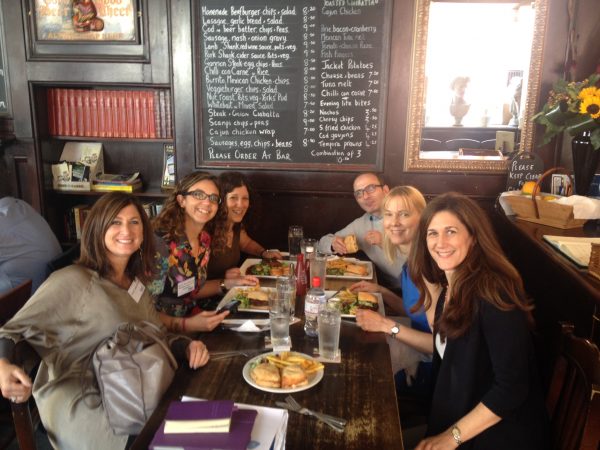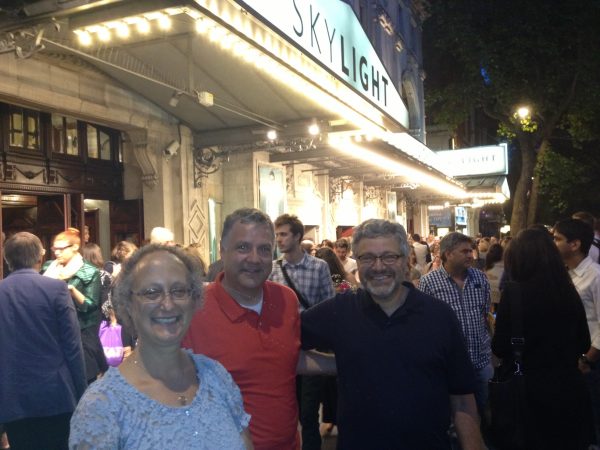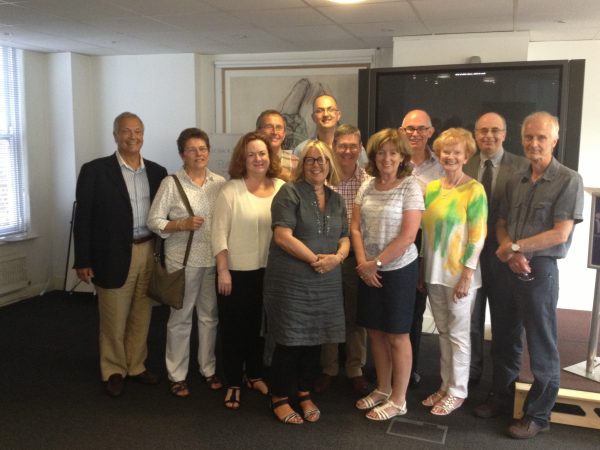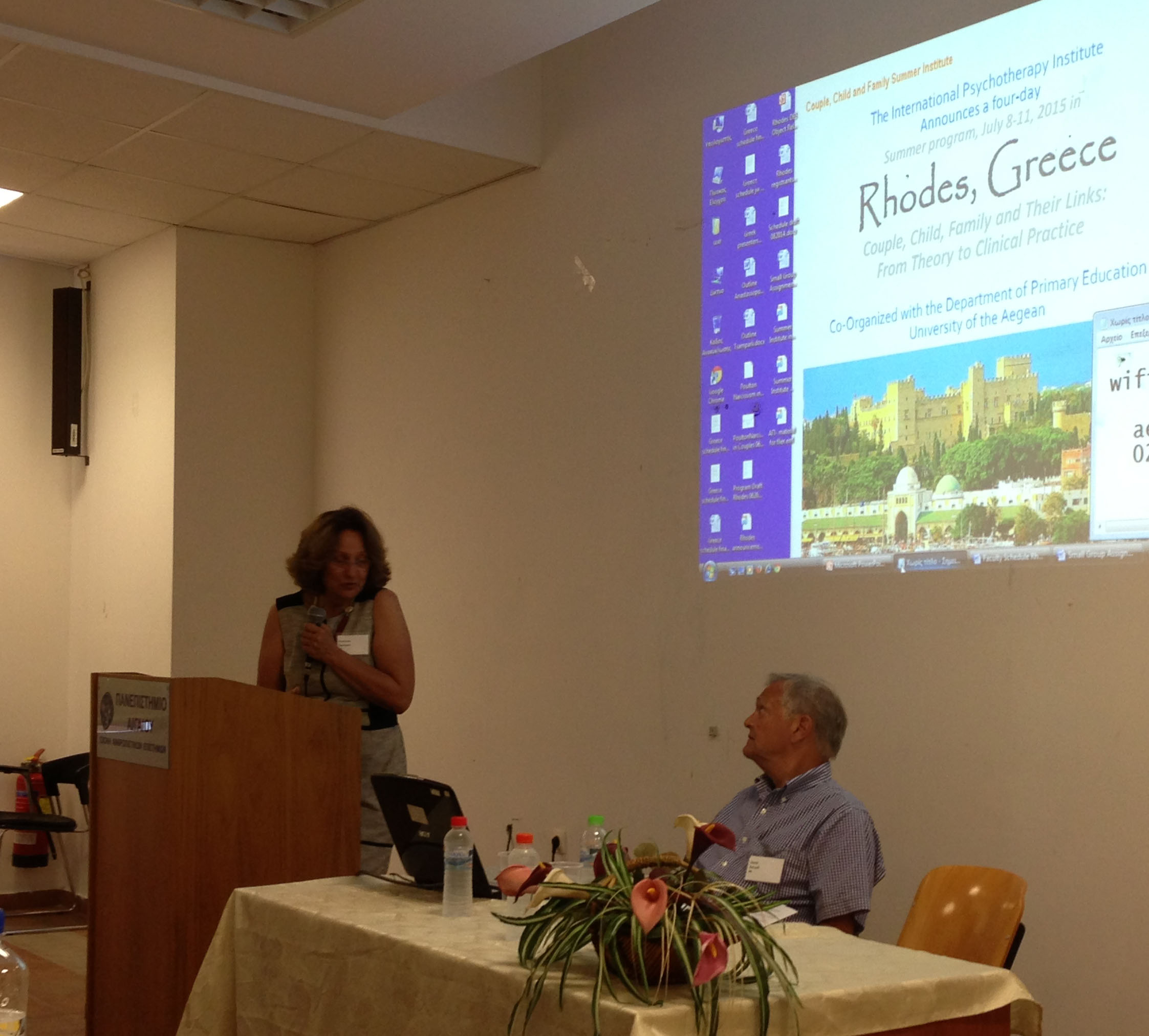Anastasia Tsamparli welcomes Greek, American, Australian and South African participants to the IPI summer institute on child, couple and family therapy at the University of the Aegean in Rhodes, as David Scharff with whom she organized the course waits to give the opening lecture
Author: Melonie Bell
The Infant-Parent Dyad with Björn Salomonsson, MD
We’ve been fascinated this weekend at IPI by Dr. Björn Salomonsson’s account of his psychoanalytic treatment of infants with their parents. To develop an effective theory and technique for helping infants in distress we need to look beyond attachment research and developmental theory to include analytic theory and technique in our approach. It’s easy to believe that the analyst’s words communicate understanding to the parent. But Dr. Salomonsson believes that he can communicate directly with the baby. Many argue that you can’t analyze a baby because analysis is a talking therapy and babies can’t understand words. Others have argued that they do. But here it is important to distinguish between the lexical and the linguistic. True, babies do not understand the words but they respond to the patterns of the language, words, the rhythm of the speech, the affective tone, the authenticity and integrity of the analyst’s interest and reach the baby and give meaning to the experience. The analyst recognizes the baby’s distress, offers calm interest and concern, and conveys hope that the unmanageable distress can be understood and coped with through a process of co-thinking between baby and analyst and between baby and parent. The analyst recognizes the competence and responsibility of the baby to become a partner in the process of recovery.
– Jill Savege Scharff, M.D.
#theipi
@theipi
#PsychodynamicWeekend
Caroline Garland on Grievance
Caroline Garland presented a psychoanalytic view of grievance, a hatred directed at that which came between the child and the gratifying, ideal maternal object. This obstacle may be the individual Oedipal rival or the parental couple, engaged in intercourse from which the child is excluded. This hatred for the parental couple is then displaced onto the analytic couple because it is not the gratifying couple of fantasy based on longing to engage in the primal scene. The hatred may be directed at the patient and the analyst in the form of a masochistic attack on the patient’s capacity to benefit from analysis and a sadistic attack on the analyst’s capacity to be effective. Revenge for Oedipal betrayal may lead to loss of hope and a suicidal act that attacks the patient’s capacity to benefit and the analyst’s capacity to be effective, and fills the analyst with shockingly intense grief. Annihilation of the self can be preferred over life in the name of revenge.
—Jill Savege Scharff
Aspects of Trauma
Caroline Garland speaking today at the International Psychotherapy Institute on aspects of trauma described how the traumatized person experiences the present trauma in the light of past trauma. Defenses against anxiety have broken down and led to extreme distress because the good objects have not been strong enough to protect against reality which now feels immensely unsafe. The person loses a sense of a personal future. When family love and supportive action is not enough, the traumatized person who comes to a therapist needs the containment of analytic psychotherapy — not hugs and action. We do not treat the trauma with compensation or solutions to block the pain. We offer a relationship in which we agree to listen and take in and bear the patient’s fear and pain and contain our reactions of helplessness and emotional distress. We need the support of analytic theory and discussion with our colleagues as we work to contain the trauma past and present and help the patient restore a sense of meaning and purpose in life.
—Jill Savege Scharff
Alvarez on Thoughts and Object Relations
Anne Alvarez is interested in how thoughts are in dynamic relation and link together. Thoughts are highly active as people are. In health thinking is not static: it is always moving on; ideas can wait in line and do not disappear. Sometimes, however, our thoughts escape us and we feel frustrated if we can’t catch them. Other times we feel crowded by them. You cannot link thoughts together if the thoughts are not given weight. What gives weight to a baby’s thought is for it to be listened to and appreciated first by the primary objects and then by the baby herself. The curious baby has a thought, implements it, and takes pleasure in the resulting sense of agency. He also becomes aware of his thought having an effect on someone else’s mind. When there is too much disturbance thoughts cannot be thought, much less connected. When there is too much greed and impatience, the child in therapy does not take time to have his thoughts. Then the analyst needs to provide a container in which thoughts are held and can wait their turn to be thought.
‘The Thinking Heart’
Anne Alvarez looked back over her clinical work of years ago and found her technique at that time insufficient for reaching the terror and despair of tormented, vulnerable children. The interpretation of projections into the therapist as defenses against wishes or of transference as resistance might be useful for those who can hold in mind two thoughts and feelings and two people at once but for these children it is better to speak not of wish but of rightful need so that the children know you understand their need for rectification of deficit. For instance, the child who seems indifferent to the analyst might wrongly be thought of as omnipotently defending against need but Anne Alvarez points not to defense against need but to lack of interest because of having had no interesting or interested object to look up to. Once that child knows the therapist is interested in him, he can become interested and eventually find himself interesting.
Anne Alvarez acknowledges aggression ( how could she not when the child has just put her neck out of alignment) but she cautions against interpretive emphasis on the death wish. When a child becomes angry or horrendously anxious about a weekend separation, rather than say to the child “You are showing me that you want me to die” or “You are afraid that I will die” she suggests saying, “It’s hard to believe I will still be here on Monday”. I enjoyed her emphasis on looking for the good, reliable, interested, surviving object. The child can identify with that good object because the analyst relates positively to the child and to the stability of the therapeutic contact, and she welcomes the child’s identification.
IPI November weekend conference
Anne Alvarez is presenting today at IPI at the conference called The Thinking Heart (the same name as the title of her excellent book). Anne described three levels of therapeutic response — 1) explanatory, 2) descriptive, and 3) intensifying and vitalizing — depending on the state of mind of the patient. At the explanatory level the analyst makes an interpretation about what the patient is projecting into the analyst and why he needs to. At the descriptive level she describes what the patient feels and does not address why. Both these approaches involve addressing the patient directly as “you” but in some states of mind the patient experiences a “you” comment as persecutory. At the intensifying and vitalizing level, she simply says to the patient “it” is upsetting, acknowledging and sharing the experience without intrusion and without insisting on “you” and “I”.
‘Inside the Mind of the Child and the Parent” October 17-19, 2014
At the IPI weekend ‘Inside the Mind of the Child and the Parent” October 17-19, 2014, Vali Maduro and Janine Wanlass made an interesting distinction among our therapeutic approaches with adults, adolescents, and children. We adjust our approach to their manner of communicating unconscious conflict: Adults communicate in words and dreams; children communicate in play, and adolescents communicate in actions. Jill Scharff described the importance of working with couples as parents. We open a space for them to talk about their child, hear their complaints and disappointments, help them face their fears, and develop with them an emotional language with which they can think about and communicate with their child. Some of them may work in depth, seeing how they express the link to their own parents and to each other in the way that they parent their children, and learning how their difficulties as a couple tend to reflect unconscious aspects of their couple conflict.
Judith Chused, MD on the use of the analyst
To see us as separate beings with minds of our own, patients must have the capacity for mentalization. But they lose it temporarily in the course of therapy. Thus at times we are seen as real objects and at other times we become transference objects, misperceived in the light of forbidden fantasies, desires and affects, our neutrality hidden under a transference veil. It is the therapist’s abstinence that encourages thickening, of the transference veil. We want it to thicken so that we can see it clearly. Working with this transference over the course of treatment draws back the veil and allows the patient to see the analyst as a new object for use in the continuing development of the person.
News of IPI participants at the TCCR-IPI summer institute in London
David Scharff and Janine Wanlass led a collaboration with TCCR to join in teaching and group-leading at the TCCR 2014 summer school “When a Twosome Becomes a Threesome: Developing and Advancing Skills in Couple Therapy” held at the Tavistock Centre for Couple Relationships in London, England. David and Janine were joined by Jill Scharff and Caroline Sehon of IPI’s Child, Couple and Family program faculty. Participants in the summer school included IPI members Frank Barone, Sam Filomena, Karen Greenberg, Jenina Lepard, Carla Trusty-Smith, and Joseph Weber, and IPI couple therapy videoconference participants Matitiaou Schliachter (from Israel) and Tertia Myers (from South Africa).
In the advancing skills track, Janine and Caroline related their presentations to the summer school theme “When a Twosome Becomes a Threesome” whereas David showed a video on projective identification. Others presenting from TCCR included teachers who have participated at IPI – Andrew Balfour, Pierre Cachia, Chris Clulow, David Hewison, Damian McCann, and Mary Morgan. Twice a day there were small discussion groups that we co-led with our TCCR partners. Janine was partnered with Liz Hamlin, Jill with Patsy Rhys, David with Viveka Nyberg, and Caroline with David Hewison as co-leaders of these groups. These were clinical case discussion groups to which the co-leaders consulted, not affective learning groups, as we have at IPI.
The group led by Janine and Liz, which was in the developing track, entered into discussion of clinical cases, where participants began to consider how couple work differs from individual work, the complicated transferences that emerge in couple work, and points of impasse in conducting couple treatment. Janine found that working with Liz and blending leadership styles from IPI and TCCR created a productive atmosphere for students to explore couple dynamics.
The groups led by David, Jill and Caroline in the advancing skills group were faced with a late change in the task. Our groups were to apply a modified version of the “Tuckett model” to process notes presented by each of the participants on an ongoing couple therapy (Tuckett et al. 2008). The original Tuckett model focuses on one case intensely over 2 days. Under the leadership of David Hewison, Head of Research at TCCR, the Tuckett model was modified to focus intently on 5 aspects of 6 cases over the 4 days of the summer school, and of course it applied to couple therapy process notes, not psychoanalysis. The group carried out the task by listening to a therapist’s process notes from a couple therapy, and without further input initially from the therapist, and categorizing what had happened in answer to 5 key questions (adapted from Tuckett) about the case material that they presented. These questions comprised (a) What does the couple therapist listen to, as evidenced by the therapist’s response? (b) How does the clinician envisage the clinical situation? (c) What is the couple therapist’s model of change? (d) What does the clinician think will further the clinical process? (e) What is in the way of the couple realizing a healthier relationship? At times, some participants resisted this challenging task, feeling frustrated that they didn’t get the “supervision” that they came for, and missing the freedom to say whatever came to mind. At other moments, students recognized the value of learning from a vantage point that differed from the experience-near, affective learning model. Many students left feeling quite intrigued by the model, and reported that it sharpened their thinking about diverse elements of theory and technique and how these are influenced by the interplay of culture, therapist training, and other factors.
Enthusiastic participants wrote about their experiences: “My associations to various lectures and discussions continue both in sessions and in other parts of my life. One concept that crystalized for me was the notion that couples have a ‘Third Position’ which involves the relational container and how this position can be greatly affected by others brought into it. I’m fascinated by the therapist’s action to enter and affect that space, and work with projective elements in it with the goal of enhancing its holding function for the couple” (Frank Barone, USA).
“The most rewarding part of the TCCR Summer School was to finally meet the faces from the videoconferencing in the flesh. Feeling quite isolated in South Africa at times, it was wonderful to have a sense of being part of an international community of couple therapists. The small group/case presentations were the most challenging part of the Summer School and it proved hard to stick to thinking about what the therapist was thinking and intending. All in all it was a very enriching experience” (Tertia Myers, SA).
“One highlight from the TCCR experience for me included the multicultural perspectives evident in how therapists work with their cultural context and dynamics. South Africa, Australia, Israel, Italy, England, US were all represented in our small group!I enjoyed exposure to the Tuckett model as a different way to think together about various therapy approaches within a psychoanalytic spectrum, and I appreciated the space at the conclusion of the week to consider other applications of the model based upon what did and didn’t work as well this time around. It was fun to make new friends from around the globe, to see the TCCR in operation and meet in person those with whom I have studied on video conference for many years!” Carla Trusty-Smith.

“I thoroughly enjoyed sharing the struggles and satisfaction of applying psychodynamic principles to couples work. A big surprise for me was how the concept of projective identification became vividly animated when I experienced it applied to couples work. I began to learn to help partners untangle and reclaim their best and/or most painful parts of themselves in order to provide fertile ground for genuine intimacy to grow in their relationship” (Joseph Weber).
On a social yet serious note, the whole conference decamped to the theatre to enjoy Skylight, the David Hare play about the rekindling of a relationship between an older widowed man and his former live-in lover, played by Bill Nyghe and Carey Mulligan. During the intermission, because the performance was being filmed, we were privileged to hear a live interview with the playwright by Emma Freud (Freud’s great-granddaughter) the host of National Theatre Live. In the conference the next day, a spirited discussion evolved concerning the echoes of oedipal triumph and guilt, dependency and independence, and the clash of values between the wealthy and those (like therapists) committed to service.

At the close of the conference, TCCR held a book-launch reception for the newly released Karnac book Psychoanalytic Couple Therapy: Foundations of Theory and Practice, edited by David and Jill Scharff with the collaboration of David Hewison, Christel Buss-Twachtmann and Janine Wanlass. The book, a co-operative compendium on how to work with couples in psychoanalytic psychotherapy, features chapters by those at IPI and TCCR who have given presentations and discussions in the videoconference course on couple therapy organized by David and Janine. Professor Brett Kahr introduced Psychoanalytic Couple Therapy as “the most comprehensive” book on the topic, “the most rigorous, and the most readable, and written, moreover, with the profundity of understanding offered by the psychoanalytical lens.” He predicted that it would “become the standard textbook in our field.” Over a glass of wine and a few tasty appetizers, we savored the culmination of our efforts, and expressed our gratitude for the fruitful collaboration of TCCR and IPI.

We all enjoyed our co-leading pairs, and made time to talk together after our groups. We learned again about the privilege of a good environment for the learning task and the importance of processing our experiences with our groups. During the summer institute, several conference participants, some of whom had not previously encountered IPI, expressed an interest in joining the IPI-TCCR couple therapy video-seminar series. David and Janine hope to create an equally compelling summer institute on couple and family therapy in Greece on the island of Rhodes next summer in partnership with Anastasia Tsamparli of the University of the Aegean.
Tuckett, D. et al. (2008). Psychoanalysis Comparable and Incomparable. London: Routledge.


